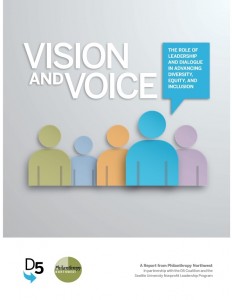Let’s face it: we have some work to do in philanthropy.
Despite deeply held commitments to building vibrant and healthy communities for all residents, many philanthropic organizations have long struggled to truly embrace equity, diversity, and inclusiveness within their own workplaces.
One telling example can be seen in how few people of color hold high-level leadership positions within our sector. A recent survey of foundations throughout the country found that a startling 92 percent of CEOs/Presidents and 87 percent of board members are white.
It is a confounding paradox to say the least. Organizations like Pride Foundation know the change we want to see in the world. Yet we are sometimes challenged to adequately practice it in our day-to-day work, especially when it comes to racial and economic diversity.
As the world of philanthropy seeks to keep up with the ever-changing needs of the diverse communities we serve, how can we make sure that we are recruiting, retaining, and supporting people of color in our work? How can we continue bringing varied cultural perspectives to the table to maximize our impact as inequities within our community grow?
Fortunately, D5, a five-year coalition comprised of some of the nation’s top foundations, was established to address these questions and more—with the goal of advancing diversity, equity, and inclusion throughout the philanthropy sector.
Mindful that the commitment to these values must come from organizational leadership, and that a network of support is critical to lasting change, D5 recently partnered with Philanthropy Northwest to create a peer cohort of ten foundation CEO’s whose work touches all corners of our region.
For Pride Foundation, this was an important opportunity to explore a set of significant, nuanced, and often discomfiting issues. I was honored to represent the LGBTQ funding community, and take part in regular, candid conversations with leaders from other venerable Northwest institutions, including the Bullitt Foundation, CIRI Foundation, Marguerite Casey Foundation, Meyer Memorial Trust, Oregon Community Foundation, Rasmuson Foundation, The Seattle Foundation, Russell Family Foundation, and Women’s Funding Alliance
It has been a powerful, often intense, and deeply candid process to say the least. But I am pleased to report that our cohort of foundation leaders has made some notable progress along the way.
A new report entitled “Vision and Voice: The Role of Leadership and Dialogue in Advancing Diversity, Equity and Inclusion” details what we’ve learned so far.
Two big lessons stand out from my involvement in this project.
First, it all starts with organizational culture.
More than any specific policy or practice, a foundation’s operating culture often plays a large role in determining how successful it will be in advancing the values of diversity, equity, and inclusion.
There are many variables that shape success:
- The examples leaders set for staff;
- How much the organization truly values learning;
- The frequency with which leaders, board, and staff discuss race, sexual orientation, gender identity, disability, class, and other forms of inequity;
- A willingness to experiment with policies for recruiting and retaining diverse candidates;
- The extent to which team members can build trust by sharing life experiences with one another;
- And the unique variables (political, social, cultural) associated with the place where you work.
The second major learning is that leaders need support from peer networks to advance diversity, equity, and inclusion.
The field of philanthropy is more likely to advance these values if it can create regular, direct, and honest in-person conversations between and among leaders, boards, and staff. It is easier to discuss your vulnerabilities when you know those you’re talking with are also facing similar challenges. Peer-to-peer mentoring makes it safer to let your guard down, which in turn makes it easier to learn and improve. There is truly safety in numbers.
These lessons have real implications for the way we do our work at Pride Foundation.
From refining and reaffirming the equity language in our latest strategic plan to looking with fresh eyes at our administrative, personnel, and programmatic priorities, we are widening the ways we think about diversity, equity, and inclusion at every level.
We know we must continue to test our own assumptions. And we must be mindful that the challenges confronting the LGBTQ community are not limited to sexual orientation and gender identity alone. As you will see in Carmel Aronson’s story, which documents how she aligned her cultural, religious, and sexual identities—we are all multi-dimensional beings, and the organizations where we work and invest our time should be places of safety and openness for all.
Thank you for your support as we continue our journey and advance our learning to be the most effective and responsive philanthropic partner we can be for our entire community.
Kris Hermanns is Pride Foundation’s executive director. Email Kris.
